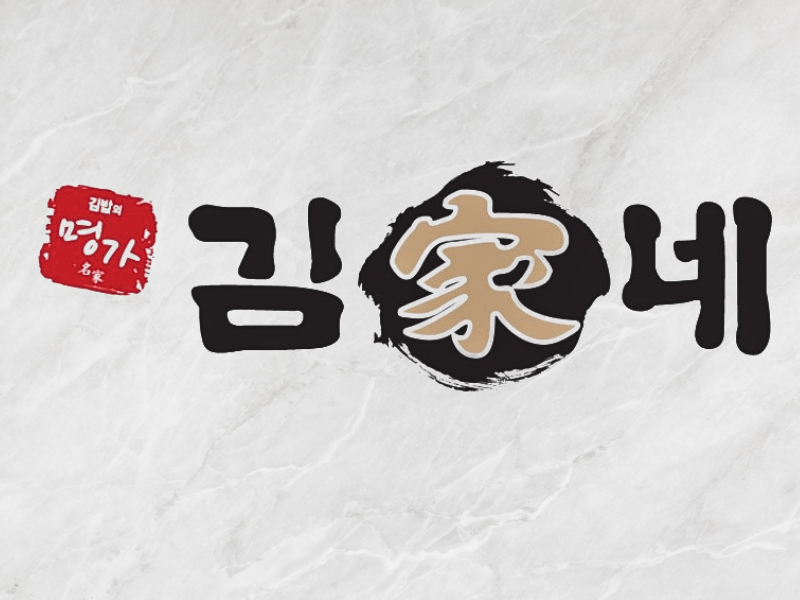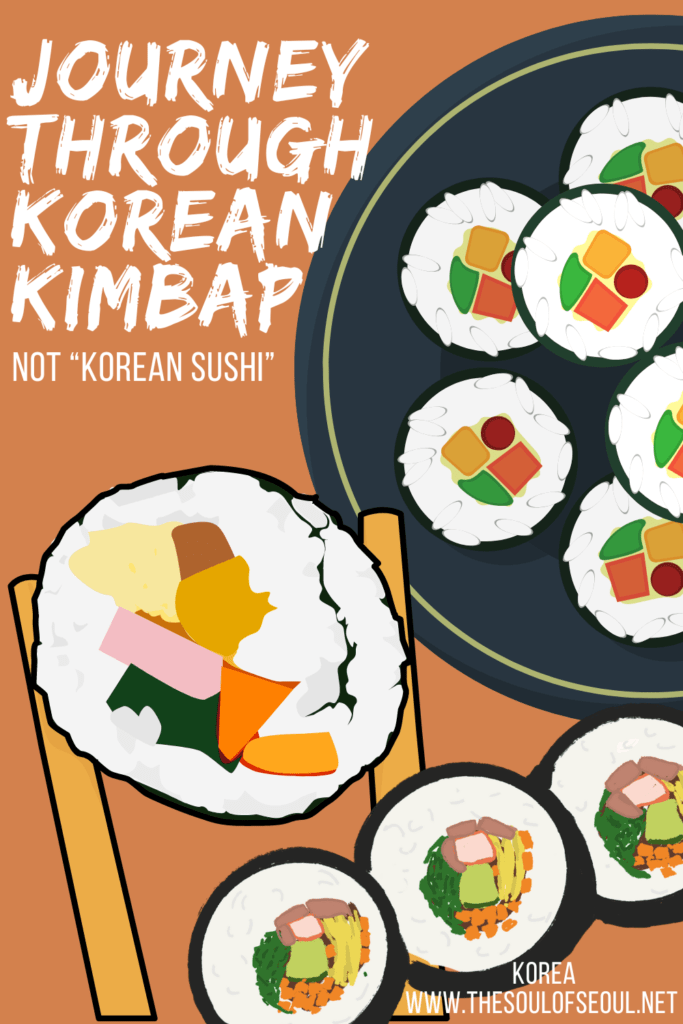A Tasty Journey Through Korean Kimbap: More Than Just “Korean Sushi”
Last Updated on March 20, 2024
I watched a video where a woman referred to Korean kimbap (김밥) as “Korean sushi” and I wondered why that moniker would ever start considering there’s no raw fish. Not to mention, it’s not Japanese, doesn’t have wasabi… okay, we’ll get to the differences between sushi and kimbap later.
Suffice to say, I love kimbap, it’s a Korean food staple and if you are a newcomer and don’t have any knowledge of the budget friendly Korean food offering that is pretty darn versatile, let me fill you in on the delectable variety of kimbap available and the common misconceptions about this popular Korean food.

Korean kimbap is a Korean food staple that is budget friendly and delicious. Get ready to learn all about it:
- What exactly is kimbap?
- Kimbap vs. Sushi: Spotting the Differences
- Kimbap isn’t always in roll form
- How many kinds of kimbap are there?
- Where to eat kimbap in Korea
(This post contains affiliate links, which means I receive a certain percentage of a sale if you purchase after clicking at no cost to you. Thank you for your support.)

What exactly is kimbap?
Kimbap (or gimbap) is a Korean roll consisting of rice and various fillings, rolled in seaweed sheets. The term itself combines the words for seaweed (kim (김)) and rice (bap (밥)), highlighting the simple, yet essential components of this dish.
Although it shares a resemblance with Japanese sushi, kimbap boasts its own distinct identity. It’s a popular choice for picnics, quick lunches, and as a tasty snack, often accompanied by pickled radish or kimchi.

In Korea, kimbap holds a special place in the culinary scene. It’s not just a meal; it’s a part of the culture. To be honest, when I first decided to write this article, I really had to search for pictures I’d taken of kimbap because it’s just so common and the everyday food that I guess I hadn’t realized some people might not know much about it.
From “first kimchi, second kimbap” sayings to its presence in nearly every Korean restaurant worldwide, kimbap’s popularity is undeniable.

Kimbap vs. Sushi: Spotting the Differences
While kimbap and sushi might look similar at first glance to the unaware, there are several key differences to note:
- Rice Seasoning: Kimbap rice is seasoned with sesame oil, giving it a slightly sweet flavor, whereas sushi rice is seasoned with vinegar.
- Fillings: Unlike sushi, which often features raw fish, kimbap fillings range from grilled beef and tuna to kimchi and cheese, making it a hearty and versatile dish.
- Accompaniments: Sushi is commonly served with wasabi and soy sauce, but kimbap is typically enjoyed with pickled vegetables and without the need for extra dipping sauces.
These differences not only distinguish kimbap from sushi but also contribute to its unique taste and appeal. To be clear, I don’t think kimbap should be referred to as “Korean sushi” at all or ever.
Kimbap isn’t always in roll form
While you’ll most commonly see kimbap in thick roll form, it doesn’t always come like that and if you’re a newcomer to the idea of Korean kimbap, I don’t want you to be surprised when you’re given kimbap in different form.

Triangle Kimbap (삼각김밥): Convenient and iconic, perfect for on-the-go eating, you’ll find triangle kimbap in convenience stores a lot. Look closely at the plastic that surrounds it to understand how to properly unwrap it so the rice sheet stays on.

Chung-mu Kimbap (충무김밥): Simple yet spicy, these rice rolls are perfect for those who appreciate a kick. A variety of kimbap that originated in Chungmu, or Tongyeong today, rice is wrapped in seaweed in a smaller bite-sized shape. They don’t have any other fillings but are served with radish kimchi on the side.
It’s said this version was created by wives of fishermen who wanted to provide a good lunch for their husbands that wouldn’t go bad while they were out on their boats.

How many kinds of kimbap are there?
The great thing about kimbap is that there are so many varieties that you’re bound to find one that you like. You can have simple everyday options, but there are some shops that go all out and list more than a dozen kinds of kimbap on their menus. On top of that, there are regional varieties to look for when you’re traveling in Korea too.
Some must-try kinds of kimbap:
- Traditional Kimbap (원조 김밥): The classic, filled with carrot, spinach, and radish, beloved by all. This is what you’ll usually find in kid’s lunchboxes and where you should start if you’ve never tried kimbap before just so you know the common base.
- Vegetable Kimbap (야채 김밥): A veggie lover’s dream, packed with fresh cucumber, radish, and perilla leaves, this is a great option if you’re vegetarian.
- Tuna Kimbap (참치 김밥): A popular choice with a mayonnaise tuna inside. This is my go-to when I’m out and about and need a quick bite on the go.
- Beef Kimbap (쇠고기 / 소고기 김밥): Juicy beef that satisfies with every bite, often enhanced with Korean sauces, this option is good if you’re a beef lover.
- Cheese Kimbap (치즈 김밥): There’s a love of cheese slices in Korean food. You’ll find cheese slices added to ramen, tteokbokki and all kinds of other things and kimbap isn’t left out either.
- Nalchial Kimbap (날치알 김밥): Featuring flying fish roe for a burst of oceanic flavor.
- Egg Kimbap (계란 김밥): Wrapped or filled with egg for a satisfying, protein-rich snack. Some places slice the egg up really thin while others wrap the entire kimbap in egg. Delicious either way.
- Nude Kimbap (누드 김밥): With rice on the outside, this variant plays with the traditional kimbap structure.
- Anchovy Kimbap (멸치 김밥): One of my favorites, the anchovy adds a salty kick to the kimbap. Watch out though, some places make the anchovy extra spicy so it’s a salty and spicy kick!
- Kimchi Kimbap (김치 김밥): Combining two Korean staples for a tangy, spicy roll. If you like kimchi, get this option and see if you can eat it all.
- Pork Cutlet Kimbap (돈까스 김밥): Crispy pork cutlet offers a delightful texture contrast. If you’re looking for something heavier, this is a great option for your meal.
- Short Rib Patty Kimbap (떡갈비김밥): Need something a bit meatier? Go for this option with Korean short rib patty slices up inside.
- Mayak Kimbap (마약 김밥): Miniature rolls that are addictive, served with a special wasabi dipping sauce. Mayak is the term for drugs in Korean and this is said to be so addictive it’s like drugs.
Each of these types brings something unique to the table, whether it’s the flavors, textures, or the sheer joy of trying something new.

Where to eat kimbap in Korea
In Korea, you can find kimbap all over the place. You don’t really have to go out of your way to find it, though I suppose there are some brands that make it better than others. So, here’s where to get kimbap in Korea… well just some of the places because, again, you can find it EVERYWHERE!
Kim Ga Ne (김가네)
A well-known bunshik-jib (분식집), or inexpensive restaurant with simple Korean meals, Kim Ga Ne has great kimbap rolls – they’re big and full of vegetables and other filling.
Their kimbap can be a little more expensive than other shops, but it’s worth it. The fillings are fresh and provide the perfect combination of soft and crunch.

Kimbab Cheonguk (김밥천국)
One of the first places I ate at, Kimbab Cheonguk meaning Kimbab Heaven, similar to Kimbab Nara (김밥나라) meaning Kimbab Country, another popular brand, serves up quick and budget-friendly meals including loads of kimbab… along with the other 50 items on their menu.
These brands can be simple and straightforward but are the most common places to get kimbap in Korea. I find the kimbab quality really depends on the woman manning the kimbap station though.

Suadang (수아당)
If you’re looking for some really good kimbap, not a chain, but a spot that is well-known for kimbap, then you need to visit Suadang. They have around 30 different kinds of kimbap so you could go again and again… and again and again. You get my drift.
Their Korean rolls are large, in charge, and delicious. Make a note though, they’re take out only.
- Address: 33 Dongsomun-ro 20ga-gil, Seongbuk-gu, Seoul (서울 성북구 동소문로20가길 33)
- Hours: Every day: 7:00am ~ 11:00pm

Fully Gimbap (풀리김밥)
Maybe you’re picky or maybe you like to be in control, whatever the reason, maybe Fully Gimbap is where you should go. Similar to Subway, in this kimbap restaurant,you can walk the line pointing out exactly what you want in your roll. With 11 proteins, 2 vegan options, 6 vegetables, 3 rice, and 5 additional toppings, there are about 260 different combinations of gimbap available.
- Address: 26 Seongsuil-ro 10-gil, Seongdong-gu, Seoul (서울 성동구 성수일로10길 26)
- Hours: Monday – Friday: 9:00am ~ 8:30pm; Saturday – Sunday: 11:00am ~ 8:00pm
TongTong Kimbap (통통김밥)
Korean presidents and local celebs are known to eat TongTong kimbap. Their signature dish is ‘Healthy Brown Rice Kimbap’ and features brown rice, instead of the standard white sticky rice you usually find in kimbap. There are a number of branches but the most popular one is in Namdaemun.
Korean kimbap is a budget friendly, a great quick bite, but can also be so versatile so don’t just pass by the next time you see a kimbap restaurant. Stop in and branch out a bit and try something new.
Did you like this post? Pin IT!



